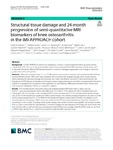Mostrar el registro sencillo del ítem
Structural tissue damage and 24-month progression of semi-quantitative MRI biomarkers of knee osteoarthritis in the IMI-APPROACH cohort
| dc.contributor.author | Roemer, Frank W. | |
| dc.contributor.author | Jansen, Mylène | |
| dc.contributor.author | Marijnissen, Anne C.A. | |
| dc.contributor.author | Guermazi, Ali | |
| dc.contributor.author | Heiss, Rafael | |
| dc.contributor.author | Maschek, Susanne | |
| dc.contributor.author | Lalande, Agnes | |
| dc.contributor.author | Blanco García, Francisco J | |
| dc.contributor.author | Berenbaum, Francis | |
| dc.contributor.author | van de Stadt, Lotte A. | |
| dc.contributor.author | Kloppenburg, Margreet | |
| dc.contributor.author | Haugen, Ida K. | |
| dc.contributor.author | Ladel, Christoph H. | |
| dc.contributor.author | Bacardit, Jaume | |
| dc.contributor.author | Wisser, Anna | |
| dc.contributor.author | Eckstein, Felix | |
| dc.contributor.author | Lafeber, Floris P.J.G. | |
| dc.contributor.author | Weinans, Harrie H. | |
| dc.contributor.author | Wirth, Wolfgang | |
| dc.date.accessioned | 2022-11-28T10:22:34Z | |
| dc.date.available | 2022-11-28T10:22:34Z | |
| dc.date.issued | 2022-11-17 | |
| dc.identifier.citation | Roemer FW, Jansen M, Marijnissen ACA, Guermazi A, Heiss R, Maschek S, Lalande A, Blanco FJ, Berenbaum F, van de Stadt LA, Kloppenburg M, Haugen IK, Ladel CH, Bacardit J, Wisser A, Eckstein F, Lafeber FPJG, Weinans HH, Wirth W. Structural tissue damage and 24-month progression of semi-quantitative MRI biomarkers of knee osteoarthritis in the IMI-APPROACH cohort. BMC Musculoskelet Disord. 2022 Nov 17;23(1):988. | es_ES |
| dc.identifier.issn | 1471-2474 | |
| dc.identifier.uri | http://hdl.handle.net/2183/32139 | |
| dc.description.abstract | [Abstract] Background. The IMI-APPROACH cohort is an exploratory, 5-centre, 2-year prospective follow-up study of knee osteoarthritis (OA). Aim was to describe baseline multi-tissue semiquantitative MRI evaluation of index knees and to describe change for different MRI features based on number of subregion-approaches and change in maximum grades over a 24-month period. Methods. MRIs were acquired using 1.5 T or 3 T MRI systems and assessed using the semi-quantitative MRI OA Knee Scoring (MOAKS) system. MRIs were read at baseline and 24-months for cartilage damage, bone marrow lesions (BML), osteophytes, meniscal damage and extrusion, and Hoffa- and effusion-synovitis. In descriptive fashion, the frequencies of MRI features at baseline and change in these imaging biomarkers over time are presented for the entire sample in a subregional and maximum score approach for most features. Differences between knees without and with structural radiographic (R) OA are analyzed in addition. Results. Two hundred eighty-nine participants had readable baseline MRI examinations. Mean age was 66.6 ± 7.1 years and participants had a mean BMI of 28.1 ± 5.3 kg/m2. The majority (55.3%) of included knees had radiographic OA. Any change in total cartilage MOAKS score was observed in 53.1% considering full-grade changes only, and in 73.9% including full-grade and within-grade changes. Any medial cartilage progression was seen in 23.9% and any lateral progression on 22.1%. While for the medial and lateral compartments numbers of subregions with improvement and worsening of BMLs were very similar, for the PFJ more improvement was observed compared to worsening (15.5% vs. 9.0%). Including within grade changes, the number of knees showing BML worsening increased from 42.2% to 55.6%. While for some features 24-months change was rare, frequency of change was much more common in knees with vs. without ROA (e.g. worsening of total MOAKS score cartilage in 68.4% of ROA knees vs. 36.7% of no-ROA knees, and 60.7% vs. 21.8% for an increase in maximum BML score per knee). Conclusions. A wide range of MRI-detected structural pathologies was present in the IMI-APPROACH cohort. Baseline prevalence and change of features was substantially more common in the ROA subgroup compared to the knees without ROA. | es_ES |
| dc.description.sponsorship | Open Access funding enabled and organized by Projekt DEAL. The research leading to these results have received support from the Innovative Medicines Initiative Joint Undertaking under Grant Agreement no 115770, resources of which are composed of financial contribution from the European Union’s Seventh Framework Programme (FP7/2007–2013) and EFPIA companies’ in kind contribution. | |
| dc.language.iso | eng | es_ES |
| dc.publisher | BioMed Central | es_ES |
| dc.relation | info:eu-repo/grantAgreement/EC/FP7/115770 | |
| dc.relation.uri | https://doi.org/10.1186/s12891-022-05926-1 | es_ES |
| dc.rights | Creative Commons Attribution 4.0 International License (CC-BY 4.0) | es_ES |
| dc.rights.uri | http://creativecommons.org/licenses/by/4.0/ | * |
| dc.subject | Osteoarthritis | es_ES |
| dc.subject | Knee | es_ES |
| dc.subject | MRI | es_ES |
| dc.subject | Progression | es_ES |
| dc.subject | Reliability | es_ES |
| dc.title | Structural tissue damage and 24-month progression of semi-quantitative MRI biomarkers of knee osteoarthritis in the IMI-APPROACH cohort | es_ES |
| dc.type | info:eu-repo/semantics/article | es_ES |
| dc.rights.access | info:eu-repo/semantics/openAccess | es_ES |
| UDC.journalTitle | BMC Muskuloskeletal Disorders | es_ES |
| UDC.volume | 23 | es_ES |
Ficheros en el ítem
Este ítem aparece en la(s) siguiente(s) colección(ones)
-
INIBIC- REUMA - Artigos [184]






